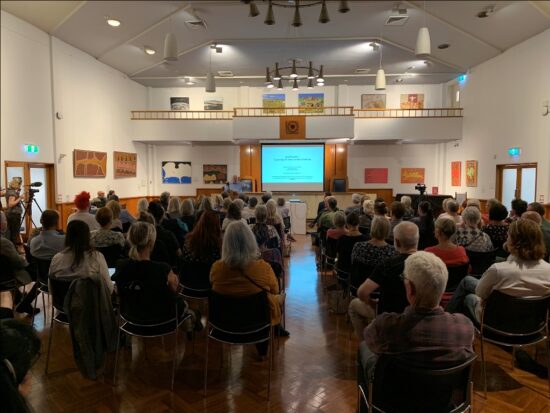EVENTS | LITHUANIA | HISTORY | MUSEUMS
◊
by Michael Samaras
◊
SYDNEY, AUSTRALIA—More than 100 people attended the Wollongong Art Gallery to hear Professor Konrad Kwiet, resident historian at the Sydney Jewish Museum, deliver a public lecture on the Holocaust in Lithuania and the wartime role of Bronius ‘Bob’ Sredersas.

Wollongong Art Gallery audience listens to Professor Konrad Kwiet on the Lithuanian Holocaust. Photo: Michael Samaras.
The community of Wollongong, an Australian city located 80 kilometres south of Sydney, was shocked last year by the revelation that Sredersas, long revered for his cultural generosity, had worked for the Nazi’s Sichererheitsdienst (SD) in Kaunsas, Lithuania, during the Second World War. Kaunas was the scene of major war crimes committed during the Nazi occupation of Lithuania from 1941 to 1944.

Photo of the “refugee” Sredersas in IRO (International Refugee Organization) files
Sredersas had come to Wollongong as a displaced person in 1950 and after working in the city’s steel industry for 25 years, donated his art collection to the community. His benefaction was the catalyst for the establishment of the Wollongong Art Gallery, which has since grown to become a significant cultural institution. In the years since Sredersas’ death in 1982, Wollongong and its gallery continually honoured his memory and founding gift.
I undertook the research that identified Sredersas’ previously hidden work with the SD and, after my work was confirmed and validated by Professor Kwiet of the Sydney Jewish Museum, all mention of Sredersas was removed from the gallery.
The lecture, held in the gallery’s main exhibition space on 30 March 2023, formed part of the Wollongong City Council’s formal response to the findings. In a room adorned with Aboriginal artworks, Professor Kwiet explained the course of events in Lithuania and detailed what had been found about Sredersas’ collaboration with the Nazis. Photographs of the Lietukis garage massacre drew gasps from an otherwise silent and respectful audience.
Professor Kwiet also announced that he had identified new evidence about Sredersas’ wartime activity, having identified an account that had a Sergeant Shroder, (the German form of the Lithuanian Sredersas), leading a group of Hitler Youths on a hunt for Jews in a forest.
“This group found a hide-out and they found a Jew who had escaped into the forest; he had escaped the ghetto deportation and was hiding there. At that stage, in late 1943, Jews who escaped deportation and went into the forest could be killed immediately on the spot.
“Sergeant Shroder did not kill the Jew in hiding, he waited until a group of Lithuanian policemen showed up to take him back to a police station where the Jew, with a Jewish star, was interrogated and he was murdered.”
At the conclusion of the lecture there was a question and answer session which included a spirited discussion amongst members of the community about what should happen to the paintings that Sredersas had gifted Wollongong. Some believed them forever tainted by the association and held they should be disposed of, while others expressed the view that the paintings themselves were quite innocent and could be appreciated in their own right.
While stressing that the matter was one for the community of Wollongong to decide, Professor Kwiet said the artworks could be used to inform and educate.
“I think now that this whole collection has obtained a very important educational function. It could be used to tell the story of immigration or multiculturalism, of the arrival of alleged war criminals, but also of refugees.”
Questioned on the appropriate fate of the paintings Darren Bark, the Chief Executive Officer of the Jewish Board of Deputies, said: “The Bob Sredersas story is a unique opportunity to inform the Wollongong and broader community about the horrors of the Holocaust and where racism, hate speech and discrimination can ultimately lead.”
It was also announced that the Wollongong Art Gallery will host a Courage to Care exhibition later this year as part of its commitment to ensuring that there is a constructive and educative response to the findings about Sredersas.
◊